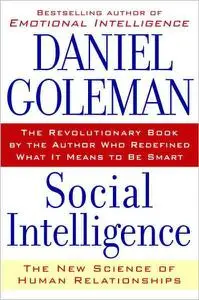Daniel Goleman, "Social intelligence: The new science of human relationships"
2006 | ISBN: 0553803522 | English | EPUB | 416 pages | 0.5 MB
2006 | ISBN: 0553803522 | English | EPUB | 416 pages | 0.5 MB
From Publishers Weekly In this companion volume to his bestseller, *Emotional Intelligence*, Goleman persuasively argues for a new social model of intelligence drawn from the emerging field of social neuroscience. Describing what happens to our brains when we connect with others, Goleman demonstrates how relationships have the power to mold not only human experience but also human biology. In lucid prose he describes from a neurobiological perspective sexual attraction, marriage, parenting, psychopathic behaviors and the group dynamics of teachers and workers. Goleman frames his discussion in a critique of society's creeping disconnection in the age of the iPod, constant digital connectivity and multitasking. Vividly evoking the power of social interaction to influence mood and brain chemistry, Goleman discusses the "toxicity" of insult and unpleasant social experience as he warns of the dangers of self-absorption and poor attention and reveals the positive effects of feel-good neurochemicals that are released in loving relationships and in caregiving. Drawing on numerous studies, Goleman illuminates new theories about attachment, bonding, and the making and remaking of memory as he examines how our brains are wired for altruism, compassion, concern and rapport. The massive audience for *Emotional Intelligence* will revel in Goleman's latest passionately argued case for the benefits to society of empathetic social attunement. *(Oct. 3)* Copyright © Reed Business Information, a division of Reed Elsevier Inc. All rights reserved. From Scientific American We all recognize a special capacity that humans have—some more so than others—to connect with others in a deep and direct way. We see this quality expressed by a performer revving a crowd, a doctor healing a patient or a mother putting a child to sleep. To orchestrate these tasks, a person must sense and stimulate the reactions and mood of another. In 1995 Daniel Goleman, a Harvard University–trained psychologist and writer for the New York Times, published Emotional Intelligence, in which he discussed the human ability "to manage our own emotions and inner potential for positive relationships." Now he goes a step further. In Social Intelligence, he enlarges his scope to encompass our human abilities to connect with one another. "We are wired to connect," Goleman says. "Neuroscience has discovered that our brain’s very design makes it sociable, inexorably drawn into an intimate brain-to-brain linkup whenever we engage with another person. That neural bridge lets us affect the brain—and so the body—of everyone we interact with, just as they do us." Each encounter between people primes the emotions. This neurological pas de deux stimulates our nervous systems, affecting hormones, heart rate, circulation, breathing and the immune system. Goleman peppers his discourse with anecdotes to illustrate the power of social intelligence. From the countertop of Rosie Garcia, a multitasking baker in New York’s Grand Central Terminal, to the tantrum-tainted class of a Texas teacher, he shows how social sensitivity and wisdom can profoundly reshape conflicts. In one encounter in Iraq, a quick-witted U.S. commander turned a Muslim mob’s threats into laughter when he ordered his soldiers to kneel, lower rifl es and smile—averting a potentially fatal clash. Goleman deftly discusses relevant neural pathways, including the thalamus and amygdala, which together regulate sensory and arousal stimuli. He speaks of spindle cells, which rapidly process social decisions; of mirror neurons, which sense another’s movements; of dopamine neurons, which react to pleasure-inducing neurotransmitters that flow freely while two lovers gaze. The author’s introductory tour through this emerging research landscape helps readers grasp core concepts of social neuroscience, illustrating abstractions with poignant anecdotes, without excessive jargon. Goleman also explains how such research may influence our lives. Given our socially reactive brains, we must "be wise," he says, and be aware of the ways that our moods influence the biology of each life we touch. *Rick Lipkin*



